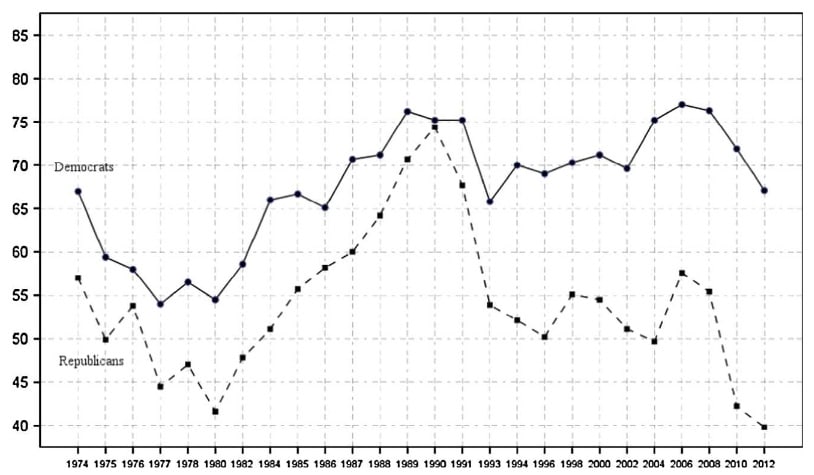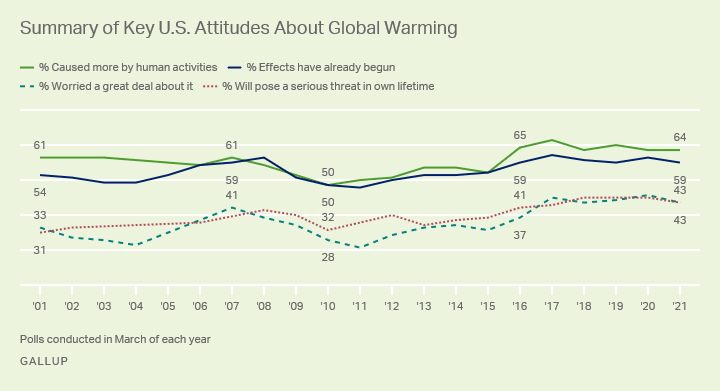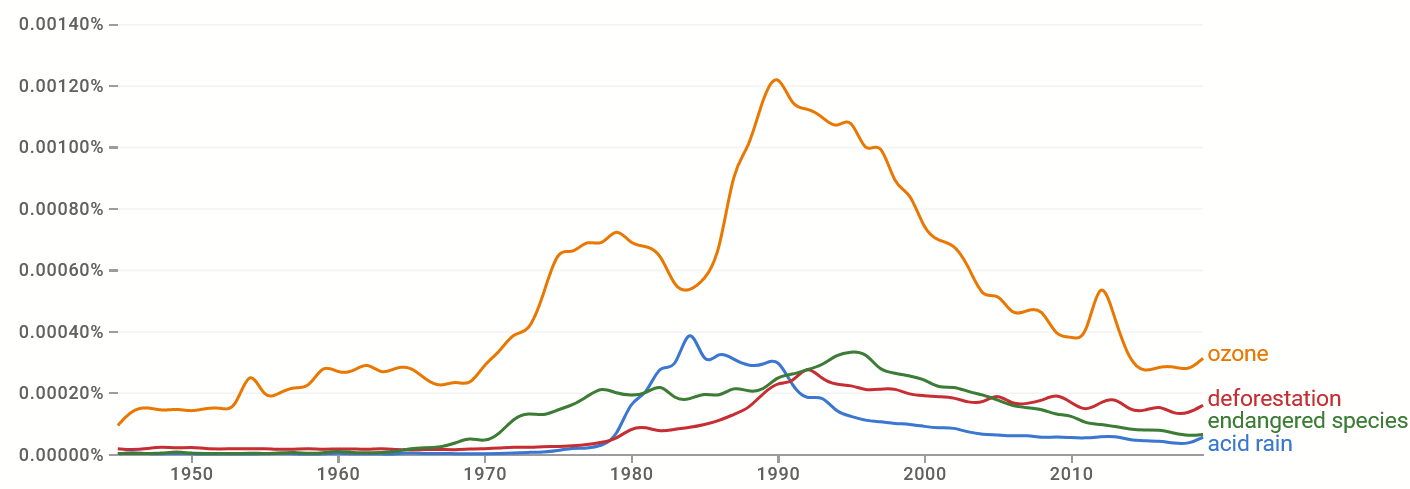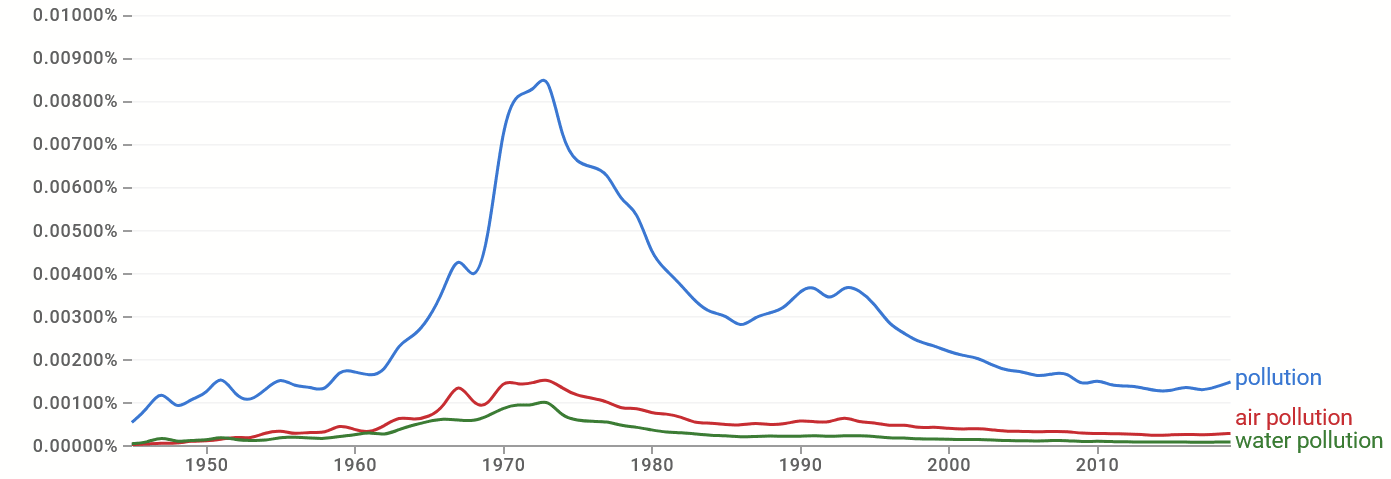This is the third in a sequence of posts taken from my recent report: Why Did Environmentalism Become Partisan?
Summary
Rising partisanship did not make environmentalism more popular or politically effective. Instead, it saw flat or falling overall public opinion, fewer major legislative achievements, and fluctuating executive actions.
Public Opinion
One hypothesis is that partisanship was useful, or even necessary, for an issue to become popular. Maybe journalists never would have covered the story if it did not involve an exciting partisan contest. The public then might have never realized that this is a thing they could care about.
The polling data do not support this hypothesis.
The clearest data from McCright et al.[1] Over 70% of both parties, and both ideologies, supported more government spending on the environment in 1990. Then, over the next 20 years, Republicans’ support for environmental spending fell dramatically while Democrat support remained roughly constant. These polls show declining overall support as partisanship increased.
Figure 1: Percentages of Democrats and Republicans reporting that national spending on the environment is “Too Little,” 1974-2012. Reprinted from McCright et al. (2014).
The Gallup data is more ambiguous.[2] It starts later, so it cannot show what was happening in the 1990s. For four different questions about global warming, Gallup shows roughly flat support from 2001-2021, although there have been fluctuations in the level of support.
Figure 2: Percentage of Americans who agree with four different statements about global warming. Reprinted from Gallup (2021).
Public opinion is not quite the same thing as public attention. Maybe partisanship increases how much people are talking about an issue, even if it has little impact on the support as measured in polls. As a proxy for public attention, I will use Google Book’s Ngram, which shows how frequently phrases appear in a corpus of English language books published each year.
For many environmental issues, there was a peak in the early 1990s. Public attention was growing prior to the issue becoming partisan and declining once the issue had become partisan. This might be because the environmental movement itself shifted focus away from these issues. ‘Pollution’ shows a similar peak around 1990, but also a larger peak in the early 1970s. ‘Climate change’ shows a somewhat different pattern: rapid growth before 1990, which then levels off until the mid-2000s, followed by resumed growth. It is possible to have increasing public attention while a topic is highly partisan, but for all of these environmental issues, public attention was flat or falling while partisanship was becoming established in the 1990s and early 2000s. Increasing partisanship does not seem to be a reliable way to attract public attention.
Figure 3a: Frequency of the phrases ‘ozone,’ ‘deforestation,’ ‘endangered species,’ and ‘acid rain’ in books each year from 1945-2019. From Google Ngram Viewer.
Figure 3b: Frequency of the phrases ‘pollution,’ ‘air pollution,’ and ‘water pollution’ in books each year from 1945-2019. From Google Ngram Viewer.
Figure 3c: Frequency of the phrases ‘climate change,’ ‘global warming,’ and ‘climatic change’ in books each year from 1945-2019. From Google Ngram Viewer.
Republicans’ opposition to climate change does not seem to be a result of a lack of information. Two polls in swing states in 2011 indicated that Republicans and Democrats with less education, or who said they know little about climate change, have similar views. As education and knowledge increase, Democrats became more concerned about climate change, while Republicans became less concerned.[3] This result is consistent with the overall trends: as time goes on, and people become more familiar with climate change, it exacerbates the partisan divide without increasing overall support.
Legislation
Many of the goals of environmentalism cannot be directly achieved by public opinion: they require new legislation.
To determine if partisanship has made it easier or harder to pass legislation, I investigated when pieces of major environmental legislation have been passed.
What counts as ‘major’ environmental legislation?
The Congressional Research Service produced a summary of the “major statutes administered by the EPA” in 2013[4] and the Library of Congress has a research guide about “significant legislation governing environmental law and policy.”[5] Any law mentioned in either of these is included.[6] I categorize these laws as dealing with environmental impact statements, air pollution, water pollution, solid waste, toxic substances, or endangered species. All of these are domestic laws – treaties will be discussed below.
These laws often create the framework of U.S. environmental policy. Newer legislation might not need to create a new framework, and instead could be an amendment to the existing framework. In addition, some of these laws superseded earlier environmental legislation. To account for both of these possibilities, I turned to Wikipedia. The sidebar of the Wikipedia article for each of these laws has a list of “major amendments.” I include each of these as a piece of major environmental legislation, checking to make sure there is no double counting.[7] I also read the History section to check for any major precursors. Each law has a well-developed article. I trust their judgment for what counts as a “major amendment” and what precursors should be mentioned more than a search and categorization I might do specifically for this report.
A graph of the number of pieces of major environmental legislation and amendments since 1945 is shown in Figure 4, binned into 4 year intervals corresponding to presidential terms.
Figure 4: The number of major pieces of domestic environmental legislation, including amendments and precursors to existing legislation, since 1945. Each four year bin corresponds to a presidential term.
There was clearly more environmental legislation passed in the 1960s-80s than in earlier or later decades. The modern environmental movement began in the 1960s and became legislatively successful within the decade. The environmental movement became partisan in the 1990s, and stopped being as capable of passing major legislation.
Treaties show a similar, if sparser, pattern. During the 1970s and 1980s, the Senate ratified four international environmental treaties unanimously.[8] The U.N. Framework Convention on Climate Change was also ratified using a division vote in 1992.[9] Between 1989 and 2001, the United States signed four environmental treaties which the Senate refused to ratify, including the Kyoto Protocol.[10] More recently, international environmental agreements have been structured so they do not require ratification from the Senate – like the Paris Climate Accords.[11]
Increasing partisanship has made it more difficult for the environmental movement to pass its legislative agenda.
Executive Actions
Environmental policy can also be enacted by the executive branch. When environmentalism is partisan, executive action fluctuates with broader political winds.[12] Over the medium-to-long term, it is unlikely that one political party will consistently win elections. Having bipartisan support for an issue results in more stable and reliable executive policies.[13]
This can be most clearly seen in international agreements. The Clinton administration negotiated the Kyoto Protocol, the Bush administration declared that they would not implement it, the Obama administration negotiated the Paris Accords, the Trump administration withdrew from them, and the Biden administration rejoined them.[14]
Much of the implementation of environmental policy occurs in the executive branch, especially the EPA. While Republican administrations have not been effective at reducing the size or budget of the EPA,[15] they have chosen leaders who have closer ties to fossil fuel companies than to the environmental movement. Many of the details of how to enact policy are small enough to not be widely reported, but some are. Examples include changing rules for air pollution[16] or removing ‘climate change’ from the EPA’s website.[17] These changes can be reversed by future Democratic administrations, but the result is that environmental protections are not consistently applied.
Conclusion
Environmentalism was a very successful movement from the 1960s-1980s. It convinced a majority of people in both parties of the importance of its concerns. It was effective at passing domestic legislation and negotiating international treaties. Presidents from both parties supported the movement.
The rise in partisanship starting in the 1990s was bad for environmentalism. Some presidential administrations are now hostile to the movement. Major legislation is still sometimes passed, but much less frequently than before. Overall public support did not increase as environmentalism became partisan.
- ^
Aaron M. McCright, Chenyang Xiao, & Riley E. Dunlap. Political polarization on support for government spending on environmental protection in the USA, 1974-2012. Social Science Research 48. (2014) p. 251-260. https://www.sciencedirect.com/science/article/abs/pii/S0049089X1400132X.
- ^
Lydia Saad. Global Warming Attitudes Frozen Since 2016. Gallup. (2021) https://news.gallup.com/poll/343025/global-warming-attitudes-frozen-2016.aspx.
Note that there are several similar questions, all which show a small or zero partisan gap when the data starts, which grows dramatically in time.
- ^
Lawrence C. Hamilton. Education, politics and opinions about climate change: Evidence for interaction effects. Climatic Change 104. (2011) p.231–242. https://scholars.unh.edu/cgi/viewcontent.cgi?article=1388&context=soc_facpub.
- ^
Environmental Laws: Summaries of Major Statutes Administered by the Environmental Protection Agency. Congressional Research Service. (2013) https://crsreports.congress.gov/product/pdf/RL/RL30798.
- ^
Environmental Law: A Beginner's Guide. Library of Congress: Research Guides. (Accessed April 29, 2024) https://guides.loc.gov/environmental-law/federal-laws.
- ^
Here is the list of laws mentioned, arranged by category:
Impact Statements:
- National Environmental Policy Act
Air Pollution:
- Clean Air Act
Water Pollution:
- Clean Water Act
- Marine Protection, Research, and Sanctuaries Act
- Safe Drinking Water Act
- Oil Pollution Act
Solid Waste:
- Solid Waste Disposal Act
- Resource Conservation and Recovery Act
- Comprehensive Environmental Response, Compensation, and Liability Act
Toxic Substances:
- Toxic Substances Control Act
- Federal Insecticide, Fungicide, and Rodenticide Act
- Pollution Prevention Act
- Emergency Planning and Community Right-to-Know Act
Endangered Species:
- Endangered Species Act
- ^
For example, the Resource Conservation and Recovery Act also appears as a major amendment to the Solid Waste Disposal Act.
- ^
The treaties are:
- Convention on International Trade in Endangered Species of Wild Fauna and Flora
- International Convention for the Prevention of Pollution from Ships, 1973 as modified by the Protocol of 1978
- Convention on Long-Range Transboundary Air Pollution
- Montreal Protocol on Substances That Deplete the Ozone Layer
- ^
The UNFCCC was ratified using a division vote, in which Senators stand for “yea” and “nay” and the presiding officer counts the number of Senators standing for each. The result of the vote is not recorded other than whether it passed. Treaties require 2/3 support of the Senate to be ratified, so it had to have had significant bipartisan support. Typically, division votes and voice votes are used when the result of the vote is not in doubt beforehand.
About Voting. U.S. Senate. (Accessed March 22, 2024) https://www.senate.gov/about/powers-procedures/voting.htm.
United Nations Framework Convention on Climate Change. Senate Consideration of Treaty Document 102-38. (1992) https://www.congress.gov/treaty-document/102nd-congress/38.
- ^
The treaties are:
- Basel Convention on the Control of Transboundary Movements of Hazardous Wastes and Their Disposal
- Convention on Biological Diversity
- Kyoto Protocol to the UNFCCC
- Stockholm Convention on Persistent Organic Pollutants
- ^
Ed King. Paris agreement ‘does not need Senate approval’ say officials. Climate Home News. (2015) https://www.climatechangenews.com/2015/12/15/paris-agreement-does-not-need-senate-approval-say-officials/.
- ^
Robert A. Wampler. The U.S. and Climate Change: Washington’s See-Saw on Global Leadership. George Washington University: National Security Archive. (2018) https://nsarchive.gwu.edu/briefing-book/environmental-diplomacy/2018-09-24/us-climate-change-washingtons-see-saw-global-leadership.
- ^
Robert A. Wampler. U.S. Climate Change Policy in the 1980s. George Washington University: National Security Archive. (2015) https://nsarchive2.gwu.edu/NSAEBB/NSAEBB536-Reagan-Bush-Recognized-Need-for-US-Leadership-on-Climate-Change-in-1980s/.
- ^
Signing the Kyoto Protocol. Clinton Presidential Library. (1997) https://clinton.presidentiallibraries.us/exhibits/show/green-building/kyoto-protocol.
Text of a Letter from the President to Senators Hagel, Helms, Craig, and Roberts. George W. Bush White House Archives. (2001) https://georgewbush-whitehouse.archives.gov/news/releases/2001/03/20010314.html.
Tanya Somanader. President Obama: The United States Formally Enters the Paris Agreement. Obama White House Archives. (2016) https://obamawhitehouse.archives.gov/blog/2016/09/03/president-Obama-United-states-formally-enters-Paris-agreement.
Michael R. Pompeo. On the U.S. Withdrawal from the Paris Agreement. United States Department of State Archives. (2019) https://2017-2021.state.gov/on-the-u-s-withdrawal-from-the-paris-agreement/.
Antony J. Blinken. The United States Officially Rejoins the Paris Agreement. United States Department of State. (2021) https://www.state.gov/the-united-states-officially-rejoins-the-paris-agreement/.
- ^
EPA's Budget and Spending. United States Environmental Protection Agency. (Accessed April 29, 2024) https://www.epa.gov/planandbudget/budget.
- ^
Matthew L. Wald. E.P.A. Says It Will Change Rules Governing Industrial Pollution. New York Times. (2002) https://www.nytimes.com/2002/11/23/us/epa-says-it-will-change-rules-governing-industrial-pollution.html.
Gavin Bade. EPA loosens Clean Air Act rules for major pollution sources. Utility Dive. (2018) https://www.utilitydive.com/news/epa-loosens-clean-air-act-rules-for-major-pollution-sources/515661/.
- ^
Laignee Barron. The EPA’s Website After a Year of Climate Change Censorship. Time. (2018) https://time.com/5075265/epa-website-climate-change-censorship/.







Executive summary: Partisanship has been detrimental to the environmental movement, leading to decreased public support, difficulty passing legislation, and inconsistent executive actions.
Key points:
This comment was auto-generated by the EA Forum Team. Feel free to point out issues with this summary by replying to the comment, and contact us if you have feedback.